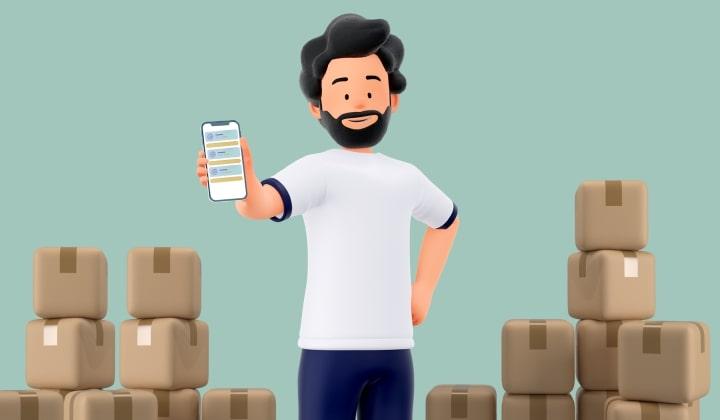At the dawn of e-commerce, this definition was quite comprehensive and meant using any device for making online purchases.
However, within the past few years the number of sales from mobile devices has almost tripled. So, a new definition, mobile commerce (m-commerce), has emerged.
What is the difference between ecommerce and mcommerce, and is it important to separate them? Learn about the latest trends in mobile commerce and the keys features of mcommerce app for a successful mcommerce app development.
Mcommerce state and predictions
In 2021, the number of smartphone users worldwide has reached 6.258 billion, which translates to nearly 80% of the entire world’s population. Moreover, the percentage of mobile phone owners is constantly increasing.
And in 2020 alone, overall mobile purchases totaled $336.98 million. This is 2.5 times more than in 2018.
Undoubtedly, the reason for such changes lies in the temporary lack of alternatives. The coronavirus pandemic has made its own adjustments in the usual pace of life in general and in the way of shopping in particular. Because of self-isolation, both businesses and customers have moved and set up online.
It is expected that by 2022, 65% of all online purchases will be made from mobile devices. So, it is much more likely that e-commerce customers will be interacting with your website from a mobile device rather than a desktop.
That is why, creating an appealing mobile shopping experience is a must-do for a retail or e-commerce business.
How is m-commerce different than e-commerce?
The key difference between e- and m-commerce is the device that serves as an intermediary between the buyer and the seller. It is that simple: if a transaction is made via a computer or laptop, we are talking about e-commerce. When a smartphone or tablet is used, it is mobile commerce.
It stands to mention that many online stores have both a mobile application and a website, i.e., presented on different platforms.
In light of this, we can deduce that mobile commerce is a faster and more modern version of e-commerce. Mobile devices are making the interaction between the buyer and the seller more convenient than ever.
Mobile-first platforms offering lawn care services are a strong example of how m-Commerce apps can optimize convenience, location-based scheduling, and real-time updates to boost customer satisfaction and operational efficiency.
Indeed, business owners have long been placing greater emphasis on mobile apps in a bid to attract users to them. A striking example is AliExpress: back in 2009, this giant was originally a website; however, today the functionality of the site is much poorer than that of a mobile application. In the application, the user will find much more attractive discounts, built-in games, and unique promotions that encourage them to come back for purchases more often. Mobile-first platforms offering lawn care services are a strong example of how m-Commerce apps can optimize convenience, location-based scheduling, and real-time updates to boost customer satisfaction and operational efficiency.
Of course, hardly anyone will be able to develop a successful m-commerce application nearly as that one. However, looking after general trends in m-commerce app development will help you determine the direction to move in. If market leaders focus on mobile applications, then this direction is the most profitable and promising.
Yet still, it is not always advisable for a small business to look up to giant platforms. The latter have been on the market for a long time and do not need additional advertising: for them, the issue of customer trust and loyalty is not so critical.
What if you still need to earn the trust of buyers when you decide to build an m-commerce app? First, take care of users’ safety.
Mobile commerce trends 2022
With the unprecedented growth in the number of retail mobile applications, the buyers’ demands grew as well. Nothing is surprising here: the higher the competition, the higher the expectations for service providers. People want to buy in stores that offer a wide range of products with their detailed descriptions, fast delivery, convenient search tool and payment methods — and no less. In addition, one wants to make purchases quickly, and for this purpose, nothing better than a smartphone or tablet was invented.
Social commerce
Nowadays, it became possible to make purchases in both separate applications of online stores and inside apps which are used on a daily basis. Not long ago, Facebook, Pinterest, Instagram, and other major platforms have implemented a buy button in their mobile apps to prevent users from clicking through multiple external links.
This offshoot of mobile commerce even got its name: social commerce. The rapidly developing direction fully embodies the optimization of retail business.
The position of retail on social networks is still rather precarious: comparably few users begin to consider social networks not only a content source, but also a marketplace.
Indeed, the implementation of side functions is not always beneficial for applications, as users initially download them for one specific purpose. Still, the retail in the mentioned applications keeps developing and attracting new followers. At the same time, it is very unlikely that most users will completely prefer social networks over online stores, which is good for the latter.
We also discuss e-commerce trends including technology advancements and expert predictions for the future in this article.
5 must-have mcommerce app features
You may also be interested in our guide on developing an e-commerce app.
1. M-Commerce data security
The safety of the user and their desire to keep shopping in a particular store go hand in hand. Security heads the list of features of mobile commerce for success. Protecting consumer’s data is a top concern of a mobile commerce business owner. As businesses face increasing pressure to comply with regulations like CSRD Reporting, ensuring data protection and sustainability practices is now a key part of their strategy. No one wants to become a victim of identity theft or illegal write-offs.
Any transaction made from a mobile device includes three components, namely:
• User — the party making the purchase • Server — the side of the mobile application owner • Connection — the connecting link between the first two, which ensures their adequate interaction.
None of these components should have security issues. Ensure continuous transaction protection and use secure protocols. The user, on the other hand, should be able to configure multi-factor authentication and have control over the geolocation function.
2. Convenient payment methods
Manual input is the worst enemy of a smartphone user. Especially when it comes to entering bank card details when paying for goods. This is a frequent occasion when shopping on websites.
One of the significant advantages of m-commerce apps is the ability to pay not only with a bank card, but also using mobile electronic wallets (Apple Pay, Android Pay), which allows avoiding typing errors and saves time.
3. High performance and reduced load time
We mentioned earlier that half of the world's population has a smartphone. Unfortunately, not all devices support the latest versions of applications and operating systems, which can affect the speed of loading screens. Try to create mobile commerce app for your business as light as possible: a long catalog loading will certainly leave a negative impression on the buyer.
Time is money. You should also make sure that the application works adequately with a weak Internet connection. Loss of connection, especially during payment, will not cause users anything but frustration.
Make sure that your mobile commerce app works great on any device by following mobile app performance best practices.
4. Outstanding user experience
All the above is another reminder not to underestimate the importance of the overall user experience, that is, the comfort when interacting with the mobile commerce application.
We have already mentioned that you should try to look at the application from different angles: through the eyes of both the consumer and the business owner. The user must understand that, from your end, you are aimed not only at making a profit, but also at building long-term relationships with them. This will be facilitated by surveys about the quality of service, feedback forms, and a welcome guide when the user runs the application for the first time.
When a client comes up with an idea for developing an m-commerce app, we always look ahead. Through our experience, we see what the client cannot see: the future. Yes, we can assume what awaits the project in perspective: users' reaction to certain m-commerce features, the convenience of making purchases in a store, and how to promote such a project.
Most often, m-commerce business owners have no idea what difficulties may arise in the future. They are in love with the idea itself and often do not see possible problems. Our mission is not just to sell the service, but to help the client optimize the budget, make the mcommerce application convenient and successful, anticipate and prevent possible problems on the project.
— Karina Suboch, Business Development Manager at SolveIt
5. User analytics and personalization
M commerce apps offer convenient tools for tracking analytics. While websites require connecting external tools for tracking business statistics, such as Google Analytics, mobile solutions allow you to analyze KPIs without third-party services. You can learn about:
• Most popular product categories • Time spent in the app • Lead conversion rate • Used mobile traffic, etc.
As a result, you will get to know your target audience better and understand what exactly it needs. By learning more about your customers, you can earn their loyalty.
The mobile app enables close customer engagement thanks to custom bug reports and social media integrations. In addition, if you enable authorization via Facebook or Gmail account, this will simplify the registration of new users.
Conclusion
Business owners invest in mobile commerce app development for many reasons. M commerce application provide higher ROI, increase conversion, as well as customer loyalty and engagement, help in promotion, and make your brand more recognizable.
An mcommerce app is an essential attribute of a modern business. Why develop it is no longer a question: how to develop an m-commerce app is instead. Soon, about two-thirds of online purchases will be made through mobile devices, and we see this as a good reason to start developing an m-commerce application.
At SolveIt, we will help you make your business profitable and recognizable by creating a successful mobile commerce app. Contact us, and together we will think over all the details of your project.



.jpg&w=750&q=75)